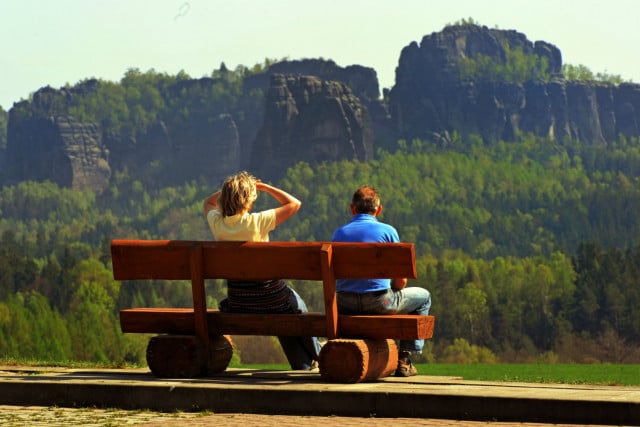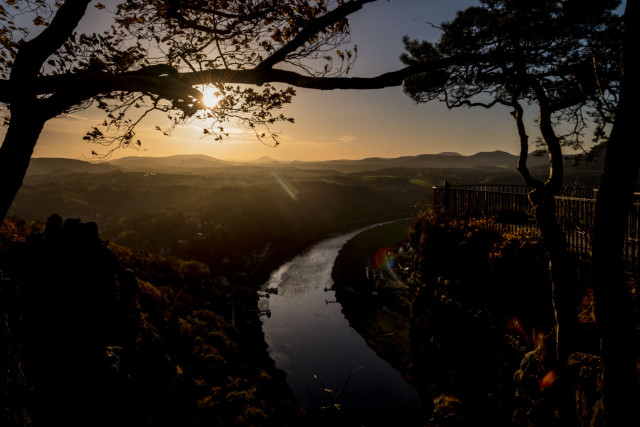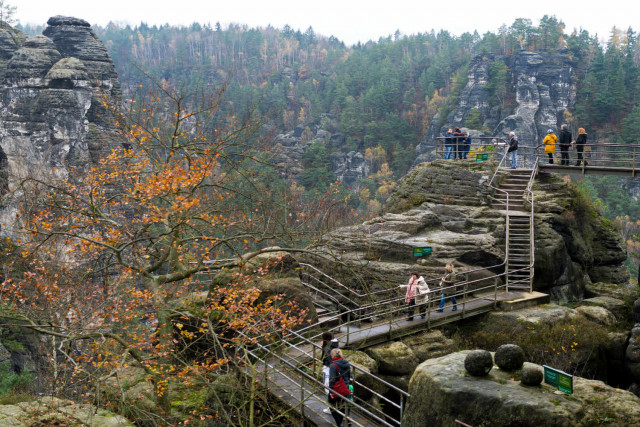Weekend Wanderlust: Scenery as far as the eye can see in Saxon Switzerland

An easy day-trip from Dresden or even Berlin, the uniquely beautiful Saxon Switzerland is not to be missed, including when temperatures dip.
“Winter is sin, spring is penance, summer is a state of grace and autumn is perfection.” Four centuries have passed since poet Angelus Silesius penned these words about the German seasons, but there is little in them to take issue with today.
Who hasn’t spent March and April pleading to any higher power who’ll listen to breath a bit of warmth back into the air? That said, no one who woke up in a bath of their own sweat this July would describe summer 2018 as a state of grace.
But no one can say a bad word about den Herbst. A cooler sun allows us to leisurely stroll the streets of Berlin or Hamburg, finally freed from the hectic masses of summer tourists. And in the great outdoors this country of vast woodlands comes into its own.
Several regions mark themselves out as exceptional spots to take in autumn’s Vollkommenheit (perfection). The banks of Lake Starnberg transform into a sea of red as the deciduous trees start to lose their leaves. A cycling tour around this magnificent glacial lake is highly recommendable. The rolling hills of the Eifel also become dappled in a thousand different shades of orange.
A point of inspiration
But no place I have visited compares to Saxon Switzerland in the fall. The yellow sandstone rocks and red beech trees become one long spectrum of colour. From famed viewpoints such as the Affensteine, rocks and trees in different shades of yellow and red speckle the mountainous scenery as far as the eye can see.

Hikers resting with a view of Saxonian Switzerland's marvellous Affensteine. Photo: DPA
Saxon Switzerland is famous primarily for its huge, fissured sandstone rock faces, which jut out from the valley floor as isolated pillars or huge walls. The enormous stones seem to defy gravity as they stretch forty or fifty metres into the sky. Just as impressive though is the foliage of the red beech trees, which turns a deep red in autumn and bring a dash of colour to the national park’s thick forests.
It is no accident that this region next to the Czech border inspired Germany’s two greatest romantic artists - Caspar David Friedrich and Richard Wagner. Friedrich painted Wanderer above the Sea of Fog, perhaps the most famous work of German romantic art, after several visits to the region. In Friedrich’s imagination, a hiker looks out from the top of a sandstone rocks onto a valley shrouded in fog.
Richard Wagner meanwhile told a friend: “Thank God I am in that place three hours from Dresden, Saxonian Switzerland, where I can begin to breath again as both an artist and a human.”
Thankfully for the modern traveller Saxon Switzerland is no longer a three-hour trip from Dresden. In fact these days it is reachable from Berlin within three hours. If you are coming from Dresden, all you need to do is hop onto an S-Bahn and you will be taken right into the heart of the region in less than an hour.
A day trek like no other
I set off from Berlin with two friends in the early hours of a clear October morning. Our rucksacks were packed with belegten Brötchen to make sure we would make the most of the day. The plan was to hike up two or three of the most famous sandstone rocks to take in the views and make it back to Dresden by the evening.

The rising sun over the Elbe river on October 30th, 2018. Photo: DPA
The S-Bahn route from Dresden up the Elbe valley to Bad Schandau gave us the sense that this was going to be something very special. After passing through Pirna, the river valley narrows, and jinks round corners to reveal ever larger chunks of sandstone - teasers for the breathtaking views awaiting us. On the south side, Festung Königstein Fortress, an enormous fortification that dates back to the 13th century, sits dominantly atop a huge piece of rock appropriately named Tafelberg (table mountain).
From Bad Schandau we travelled with a tiny train up the (impossible to pronounce) Kirtnitzschtalstraße. The hike began at Beuthenfall, where we made our way through a thick forest. Confident footing was required as the path wound up through steep and damp gorges and occasionally bent around exposed pieces of rock.
Less than an hour later, we reached the the Affensteine (monkey stones), a long chain of rocks that make up the most impressive feature of the national park. At Carolaflensen, we leapt over deep fissures in the rock and looked on in awe at the towers of sandstone in front of us. Below, three or four stone fingers rose out of the trees like the remains of an unbreachable ancient wall.
Folklore has it that the Affensteine got their name from the remarkable escape of a young nobleman who had been imprisoned nearby. The young man is said to have had a monkey who he taught to climb the sandstone cliffs carrying a rope, thus securing his escape into the neighbouring kingdom of Bohemia.
The story is most likely made up, but the name seems fitting nonetheless. The rocks have a bamboozling geography to them. We lost our direction for two hours before finally finding our way back to the Starke Stiege, another well-known viewpoint.

It's not too cold: hikers in November. Photo: DPA
Our hike ended at the small town of Smilka on the banks of the Elbe. The locals did their best to uphold the Saxon reputation for being less than welcoming to strangers (one man stopped and stared at us as we walked down the street as if he’d never seen a tourist before). On the other hand a mill that has been turned into a restaurant provided the perfect end to the day. The delicious Zwiebelkuchen (onion cake) and homemade beer provided just the revitalization we needed after a long day of walking.
In the winter, walks over the rocks of Saxon Switzerland become a bit riskier, depending on the weather. But if you are fearless (and experienced) enough, the sandstone turrets are a sight to behold when they are capped in snow.
Comments
See Also
“Winter is sin, spring is penance, summer is a state of grace and autumn is perfection.” Four centuries have passed since poet Angelus Silesius penned these words about the German seasons, but there is little in them to take issue with today.
Who hasn’t spent March and April pleading to any higher power who’ll listen to breath a bit of warmth back into the air? That said, no one who woke up in a bath of their own sweat this July would describe summer 2018 as a state of grace.
But no one can say a bad word about den Herbst. A cooler sun allows us to leisurely stroll the streets of Berlin or Hamburg, finally freed from the hectic masses of summer tourists. And in the great outdoors this country of vast woodlands comes into its own.
Several regions mark themselves out as exceptional spots to take in autumn’s Vollkommenheit (perfection). The banks of Lake Starnberg transform into a sea of red as the deciduous trees start to lose their leaves. A cycling tour around this magnificent glacial lake is highly recommendable. The rolling hills of the Eifel also become dappled in a thousand different shades of orange.
A point of inspiration
But no place I have visited compares to Saxon Switzerland in the fall. The yellow sandstone rocks and red beech trees become one long spectrum of colour. From famed viewpoints such as the Affensteine, rocks and trees in different shades of yellow and red speckle the mountainous scenery as far as the eye can see.

Hikers resting with a view of Saxonian Switzerland's marvellous Affensteine. Photo: DPA
Saxon Switzerland is famous primarily for its huge, fissured sandstone rock faces, which jut out from the valley floor as isolated pillars or huge walls. The enormous stones seem to defy gravity as they stretch forty or fifty metres into the sky. Just as impressive though is the foliage of the red beech trees, which turns a deep red in autumn and bring a dash of colour to the national park’s thick forests.
It is no accident that this region next to the Czech border inspired Germany’s two greatest romantic artists - Caspar David Friedrich and Richard Wagner. Friedrich painted Wanderer above the Sea of Fog, perhaps the most famous work of German romantic art, after several visits to the region. In Friedrich’s imagination, a hiker looks out from the top of a sandstone rocks onto a valley shrouded in fog.
Richard Wagner meanwhile told a friend: “Thank God I am in that place three hours from Dresden, Saxonian Switzerland, where I can begin to breath again as both an artist and a human.”
Thankfully for the modern traveller Saxon Switzerland is no longer a three-hour trip from Dresden. In fact these days it is reachable from Berlin within three hours. If you are coming from Dresden, all you need to do is hop onto an S-Bahn and you will be taken right into the heart of the region in less than an hour.
A day trek like no other
I set off from Berlin with two friends in the early hours of a clear October morning. Our rucksacks were packed with belegten Brötchen to make sure we would make the most of the day. The plan was to hike up two or three of the most famous sandstone rocks to take in the views and make it back to Dresden by the evening.

The rising sun over the Elbe river on October 30th, 2018. Photo: DPA
The S-Bahn route from Dresden up the Elbe valley to Bad Schandau gave us the sense that this was going to be something very special. After passing through Pirna, the river valley narrows, and jinks round corners to reveal ever larger chunks of sandstone - teasers for the breathtaking views awaiting us. On the south side, Festung Königstein Fortress, an enormous fortification that dates back to the 13th century, sits dominantly atop a huge piece of rock appropriately named Tafelberg (table mountain).
From Bad Schandau we travelled with a tiny train up the (impossible to pronounce) Kirtnitzschtalstraße. The hike began at Beuthenfall, where we made our way through a thick forest. Confident footing was required as the path wound up through steep and damp gorges and occasionally bent around exposed pieces of rock.
Less than an hour later, we reached the the Affensteine (monkey stones), a long chain of rocks that make up the most impressive feature of the national park. At Carolaflensen, we leapt over deep fissures in the rock and looked on in awe at the towers of sandstone in front of us. Below, three or four stone fingers rose out of the trees like the remains of an unbreachable ancient wall.
Folklore has it that the Affensteine got their name from the remarkable escape of a young nobleman who had been imprisoned nearby. The young man is said to have had a monkey who he taught to climb the sandstone cliffs carrying a rope, thus securing his escape into the neighbouring kingdom of Bohemia.
The story is most likely made up, but the name seems fitting nonetheless. The rocks have a bamboozling geography to them. We lost our direction for two hours before finally finding our way back to the Starke Stiege, another well-known viewpoint.

It's not too cold: hikers in November. Photo: DPA
Our hike ended at the small town of Smilka on the banks of the Elbe. The locals did their best to uphold the Saxon reputation for being less than welcoming to strangers (one man stopped and stared at us as we walked down the street as if he’d never seen a tourist before). On the other hand a mill that has been turned into a restaurant provided the perfect end to the day. The delicious Zwiebelkuchen (onion cake) and homemade beer provided just the revitalization we needed after a long day of walking.
In the winter, walks over the rocks of Saxon Switzerland become a bit riskier, depending on the weather. But if you are fearless (and experienced) enough, the sandstone turrets are a sight to behold when they are capped in snow.
Join the conversation in our comments section below. Share your own views and experience and if you have a question or suggestion for our journalists then email us at [email protected].
Please keep comments civil, constructive and on topic – and make sure to read our terms of use before getting involved.
Please log in here to leave a comment.